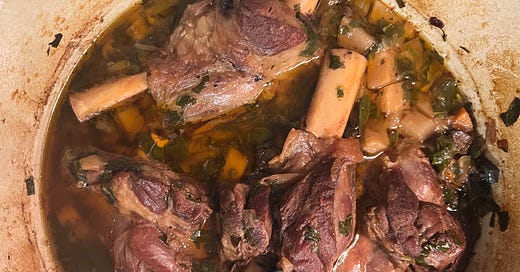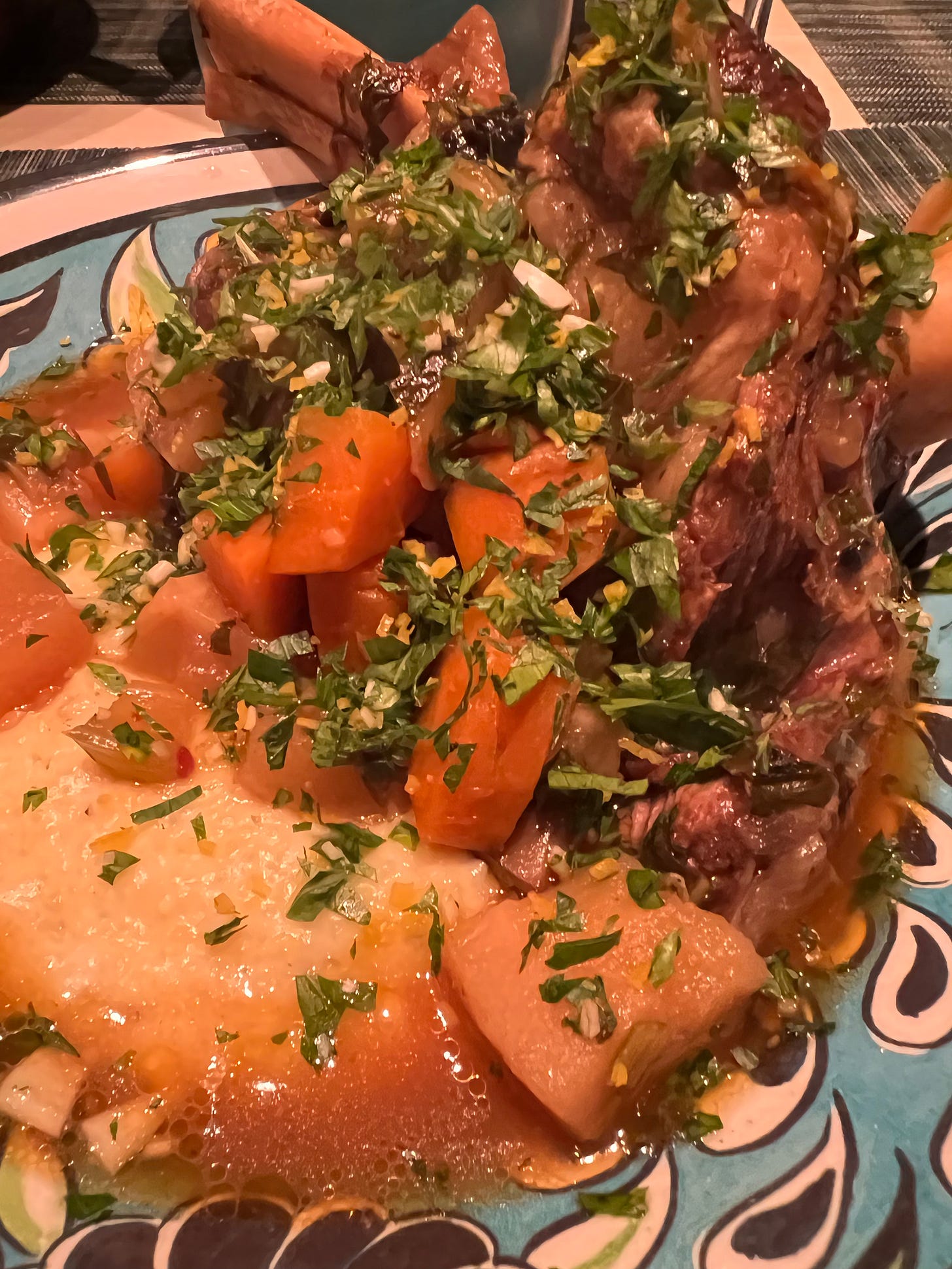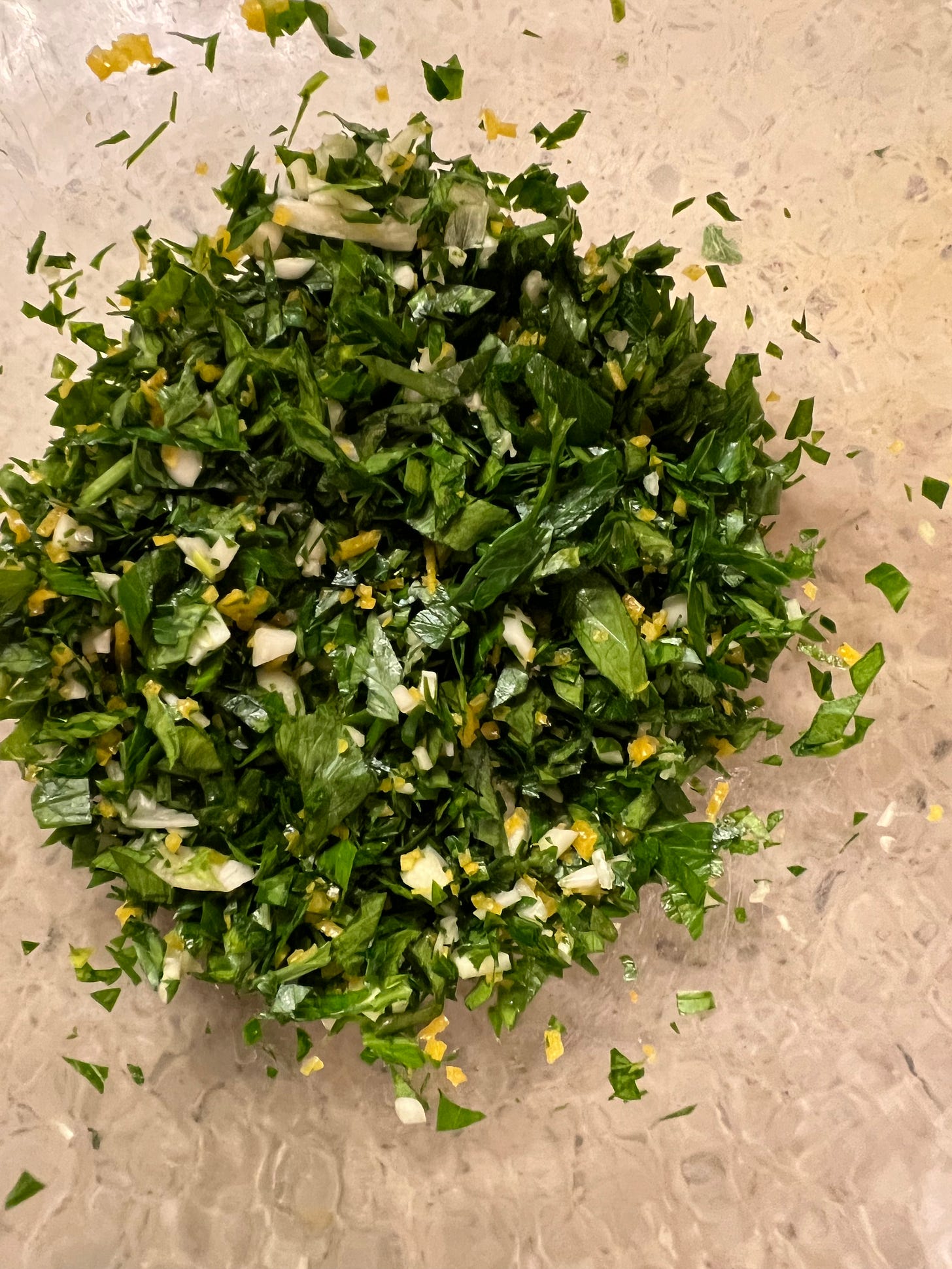Lamb Shank Redemption
Hierarchies of Food, Economics of Tastes, Shopping by App, and Governor Cuomo's Lamb Shanks
Oh, to be 29 again. Here is Issue #29, which veers into a few heady subjects considering the main focus is a simple, delicious braised lamb shank recipe. Thanks for signing up, subscribing, humoring me, and for giving the gift of the independent food writing and delicious recipes to your friends. Enjoy. — Mitchell
I remember when lamb shanks were $0.99 apiece. Grocery stores, which still had butchers onsite back then, couldn’t give them away to the mostly middle-class, mostly Jewish shoppers in the Toronto neighborhood where I grew up. Racks and chops were all anyone wanted. (The situation was quite different in the large Italian grocery stores just one neighborhood over.) This was before interest in “peasant,” “comfort,” “ethnic,” and all the other problematically termed food trends had gained the attention of national food editors, and before off-cuts and out-of-mainstream ingredients commanded top dollar, pushing them beyond the reach of those who once relied on them for (delicious) sustenance.
I was already planning to write about lamb shanks for this week’s newsletter when I came across Ligaya Mishan’s article about this gastro-socio-economic phenomenon in the New York Times’s T Magazine. Mishan notes, “Deliciousness has never been a fixed quality, wholly measurable by sensors on the tongue; it’s an invocation and reflection of memory, history and prevailing hierarchies.” It’s the hierarchies that really get my goat, so to speak. (For an interesting article on the cultural resonances of lamb and goat, read this article @raykris1 pointed the Twittersphere to.)
Having shopped and cooked for decades now I’ve seen this same cycle play out time and again. In the Jewish butcher shop I worked at during high school, brisket was a bargain cut. Short ribs, which we called by their Yiddish name flanken, were even cheaper. Now demand for both is such that the price is high and they can be hard to find, especially for humanely raised meat. It turns out no matter the demand, an animal only has so much to give.
Don’t get me wrong, I’m in no way advocating for cheap meat. Quite the reverse. I think we all need to spend a lot more on better-raised protein, and the higher cost of humanely raising animals should be more evenly distributed across all of their parts. It would be great if we could figure out how to do that in such a way that didn’t put meat in the pots only of the rich. At the very least, we need to encourage more people to be mindful about the way we categorize and prioritize foods, cuisines, even whole cultures, and ultimately, of the power dynamics that are reflected by our consumption patterns and how they play out in the marketplace and beyond.
Hot App
Lamb shanks and the marketplace have been on my mind because the other day I was trying out a new (to me) purchasing app, Mercato, that allows you to buy from purveyors in your neighborhood. I’ve used it three times and already the app and I have developed a complicated relationship.
Throughout the entire pandemic I had resisted using such shopping apps, looking forward to my lengthy strolls to favorite shops in Essex Market, Chinatown, along Bleecker Street, and through Murray Hill, which were all on my usual route. Food shopping was my only destination, essential as it was, and my pleasure. Not only did I not want to forgo the physical exercise by having something delivered, I wanted to be inspired to cook by what I saw. I wanted to see people interacting with food. I ordered local deliveries to the apartment so rarely during the pandemic that I hadn’t even realized delivery people were not allowed into our building until they were again. (Mail order was another story entirely.)
But now that the world is more open, my work calendar is more full and time has become scarce again. I’ve been trying to hold onto routines I developed during lockdown—daily tai chi practice, sourdough bread baking, Taoist chanting, knitting, marketing in the neighborhood—but it’s getting harder. It doesn’t help that like many households we now have a dog, Milo, who is sweet and lovely, but who has terrible separation anxiety—who can blame her, she’s never known life on her own. All of this has forced me to rethink my relationship to shopping remotely. I can’t always get away for a long walk to buy food anymore.
Assuming that, as for restaurants, it might be better to call and order directly from the actual stores rather than use a third-party app, the other day I dialed my two favorite butchers—Ends Meat and Dickson’s Farmstand Meats—to see if they delivered. They both directed me to the Mercato app, which I quickly downloaded. My orders arrived at my doorstep in a few hours. The packages were wrapped and labeled as if I had been in the shop. I was impressed.
The second time I went on Mercato, I was without need for anything, but I wanted to explore my options. I was stunned to see most of my favorite places, from Valley Shepherd Creamery to Kalustyan’s to the whole complement of Chelsea Fresh stores on the app. That’s when the shanks from Dickson’s appeared on my screen. I ordered them.
I stopped myself short of becoming a member (for now), although by doing so delivery in my neighborhood would be free. Even before the pandemic I always believed there was something fundamentally important about going marketing for food, interacting with sellers and producers, building relationships, learning about ingredients. Just today I saw an article in Bloomberg about how these apps will destroy communities, like ghost kitchens, and robotic baristas, and all the other things meant to improve our lives. And I don’t want to give up hope that I will continue to take long walks to buy food directly from purveyors I want to support and be inspired to make delicious things from what I see.
The Governor’s Lamb Shanks
In 1991, I was selected to be one of 29 guinea pigs on a new culinary program created by the Piedmontese government and the Gruppo Ristoratori Italiani, under the direction of restaurateur Tony May, called ICIF, the Italian Culinary Institute for Foreigners. ICIF was conceived as a place to teach the world what real Italian food was, beyond the “bastardizations” of pizza and pasta that so often stand in for a vast and varied cuisine. For six months the ICIF directions gave it their best shot. It was not a thoroughly successful program for reasons that I may share in future newsletters, but it did kindle in me a lifelong love of Italy, the Italian language, and Italian food and I made a few enduring friendships.
One of those friendships is with chef Andrew Carmellini, who was also selected for the program. A graduate of CIA (the Culinary Institute of America), Andrew had already worked for Tony May at San Domenico NY, one of the most ambitious Italian restaurants of the era. Weekends in Italy, Andrew and I and a few other friends used to travel and cook and try to teach ourselves all the great Italian things left out of our curriculum. Andrew’s knowledge and experience was already impressive to me. He had eaten horse tartare in Rome.
One day Andrew shared with me his special recipe for lamb shanks. It was special because he prepared them regularly for then Governor Mario Cuomo, for whom he worked on weekends from the CIA. He made lamb shanks for the Cuomos on Sundays, served with cannellini beans. I took notes on the recipe under the heading “Governor Cuomo’s Lamb Shanks.” I’ve never actually followed another recipe for lamb shanks since we discussed how he made them. And just this weekend, more or less, with my shanks delivered with by third-party app, I made them again.
Of course, “Governor Cuomo” has another resonance these days that leaves a really bad taste in the mouth. Not these shanks. They are delicious.
RECIPE: Braised Lamb Shanks with Gremolata
(Serves 4)
Here’s how I braised my delivery-app lamb shanks based on the recipe/technique Andrew shared with me 30 years ago. You’ll note the ingredients are similar to the soup recipe I wrote last week because those are the things I had in the fridge; they are the things I always have in the fridge. The overlap of ingredients of good cooking from one cuisine to the next make it easy to have on hand things you need to make delicious food. Served over a pile of warm, creamy polenta or mashed potatoes, these shanks are the best.
4 lamb shanks (about 4 pounds)
Salt
Freshly ground black pepper
3 tablespoons peanut or other vegetable oil
3 tablespoons olive oil
1 large onion, chopped
1 carrot, chopped
1 stalk celery, with leaves, chopped
Pieces of parsnip, turnip, fennel, or celery root, in any combination, diced
1 large clove garlic, smashed
1 small hot pepper, minced
1 tablespoon tomato paste
1 cup dry white or red wine
2 cups chicken, beef, vegetable, or other stock, cooking water, or just plain water
2 or 3 cauliflower, kale, or cabbage leaves, central core removed, chopped
1 portobello mushroom or a few reconstituted dried porcini, diced
Sprigs of thyme, marjoram, rosemary, and/or parsley
1 bay leaf
For the gremolata:
4 strips orange or lemon zest, finely minced
2 additional large cloves garlic, minced
Large handful Italian parsley, leaves and tender stems only, roughly chopped
Preheat the oven to 300°F. Season the lamb shanks generously with salt and pepper. In a large dutch oven set over high heat, heat the peanut or vegetable oil until almost smoking. Add the seasoned shanks and brown well on all sides, tilting them up to brown the ends, about 10 minutes, total. Remove the shanks to a plate and drain the oil (do not wipe out the pan). Return the pan to medium-high heat. Add the olive oil. When hot, add the onion, and sauté until translucent, about 6 minutes. Add the carrot, celery, and root vegetables, season with salt and pepper, and continue sautéing until they soften and maybe even brown a little. Add the garlic and hot pepper, and continue cooking a minute or two. Add the tomato paste and let it heat through, stirring to distribute it among the vegetables. Add the wine and let it boil off to reduce. Add the stock, chopped leaves, and mushroom, along with the herbs and bay leaf. Bring to a simmer. Add the browned shanks back into the pan, arranging them in a single layer. They should be at least halfway submerged in the braising liquid. If not, add more stock, wine, or water until they are. When the liquid comes back up to a simmer, cover the pot and transfer it to a preheated oven.
Cook the shanks about 2 hours, or until the collagen has relaxed and the meat has visibly pulled away from the bone. At about 90 minutes you will begin to sense a change in the smell of the shanks and they will smell done. They need a little more time, but this delicious aroma of braised lamb will fill your house. You can lower the oven temperature to 200°F. to keep the lamb warm for an hour or two until you are ready to eat it.
Meanwhile, for the gremolata, combine the zest, minced garlic, and chopped parsley, and mix well.
Serve the shanks in large bowls with polenta or mashed potatoes over which you should spoon plenty of the braised vegetables and cooking liquid. Sprinkle with the gremolata just before serving. The heat of the hanks should activate the flavors in the gremolata for an amazing perfume when you put the bowls down on the table.






